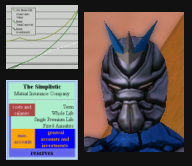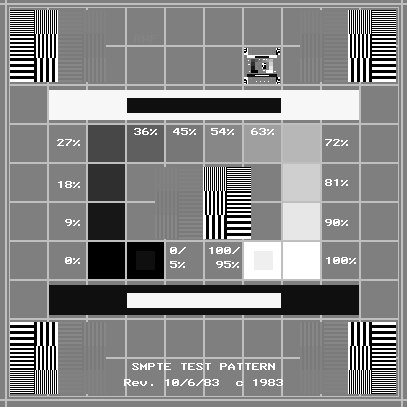Graphics and PNG
(Portable Network Graphics)

I started this area of my site in the late 1990s. My goal at the time was to be an advocate for the PNG image format, as well as discuss a limited number of more general graphics topics. I had been professionally working with imagery since the early 1980s and perhaps folks would be interested in some of what I had learned.
In college I majored in programming. I did well at Abilene Christian University (ACU), and only received a "D" in one class — you guessed it, Computer Graphics. I was graduated in 1985 with a BS in Computer Science, completing all three tracks ACU offered for that major. In the summer of 1984 I began also working full time, at Satellite Exploration Consultants (SEC). This was a small company made up mostly of geologists who used satellite imagery as one of their main tools to help oil folks find promising areas to drill. They did other kinds of studies as well.
One of their main tools was a large graphical imaging system called EarthViews, made by DBA Systems, Inc. (for whom I would later work). It offered two sets of software which both took advantage of the graphical hardware. Remember, in the early to mid-1980s, having a graphical system able to show a 512x512 full-color image was an expensive proposition. Add in the disk space for 70-megabyte, multi-channel LandSat images, and a tape drive to read the raw imagery and output the processed images, you were talking about a large, dedicated system. (Please stop laughing; I'm serious here!)
It so happened that two semesters before I got the job at SEC that I did a class project using the FORTH programming language. The project allowed us to use whatever language we wanted, and I was weird enough to choose FORTH. When I interviewed several months later at SEC, my FORTH "credentials" essentially clinched the job. One of the two software packages was AIMS, the Advanced Image Management System. It was written by Dr. George Dalke (for whom I would also later work), entirely in the FORTH language. In hiring me they not only got someone to process their images, but someone who could actually fix bugs and add features. I kept working full-time for SEC even after the summer ended, during weekends and evenings.
... back to the D received in my Computer Graphics class. In my defense, I was very busy – full time coursework and full-time job. This led me to be late on the course's main project, and industry was putting pressure on colleges to turn out programmers who could meet their deadlines. Thus I got a D- on the project, and later the C on the final did not help either...
 So here I am, fully qualified to author a sub-site relating to graphics. ;) I tend
to view the topics from the perspective of a programmer, not a phsyicist. Thus
you won't be needing to break out your calculator to figure out stuff like you see
on the right. Nor will you need to learn FORTH or Java.
So here I am, fully qualified to author a sub-site relating to graphics. ;) I tend
to view the topics from the perspective of a programmer, not a phsyicist. Thus
you won't be needing to break out your calculator to figure out stuff like you see
on the right. Nor will you need to learn FORTH or Java.
Major imagery-related projects I have worked on include:
![]() I became an early propenent of the PNG format because of its open nature.
Unlike GIF, which until expiring in 2003/2004 (depending on country), used patented,
closed technology, PNG could be used by anyone for any purpose, without royalty.
GIF could only handle 1-bit to 8-bit images, whereas PNG could handle full 24-bit color,
16-bit greyscale, and anything that GIF could do (except "animation"). I'm not
sure where it was ever used, but PNG could go up to 16 bits per color component,
so a lossless RGB image could actually be stored as 48 bits/pixel.
I became an early propenent of the PNG format because of its open nature.
Unlike GIF, which until expiring in 2003/2004 (depending on country), used patented,
closed technology, PNG could be used by anyone for any purpose, without royalty.
GIF could only handle 1-bit to 8-bit images, whereas PNG could handle full 24-bit color,
16-bit greyscale, and anything that GIF could do (except "animation"). I'm not
sure where it was ever used, but PNG could go up to 16 bits per color component,
so a lossless RGB image could actually be stored as 48 bits/pixel.
 The picture on the right is an RP-133 conformant SMPTE
(Society of Motion Picture and Television Engineers)
video test pattern. If you click on it, you will be brought to a small gallery
of PNG images.
The picture on the right is an RP-133 conformant SMPTE
(Society of Motion Picture and Television Engineers)
video test pattern. If you click on it, you will be brought to a small gallery
of PNG images.
The image you see was actually extracted from a much larger (4096x4096) image I generated to test the DFR-8000. (The full image is in my gallery.) I am a bit weird and had to throw in a fully conformant, much smaller, echo of the pattern within one of the blank squares of the larger pattern. And you can see even this echo has its own little echo. The font used was from my Amiga 1000 computer. I cannot remember how I got it onto the PDP-11 computer at work, but I did.
In 1996 the World Wide Web Consortium (W3C) recommended PNG as a web standard format. JPEG is still recommended for mid to large full color images on the web, but PNG's lossless nature still gives it advantages where maximum quality is necessary. Also, for 1- to 4-bit/pixel business graphics (charts, plots, etc) PNG will likely render a smaller image file than even JPEG.
My main image viewer and editor for this site has always been IrfanView, by Irfan Skiljan. It is a free (for non-commercial use) Microsoft Windows application which supports a wide variety of graphic formats and offered PNG support early on. Conversion between the formats is easy, and it has a large selection of image filters, cropping, and other effects.